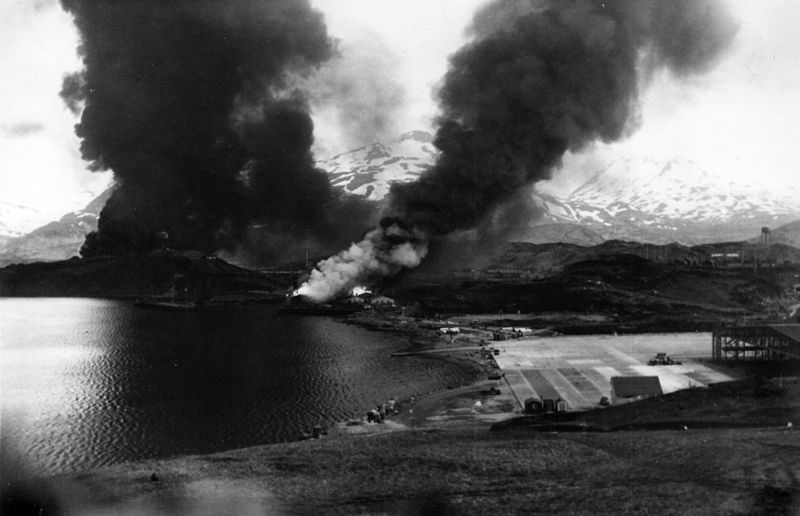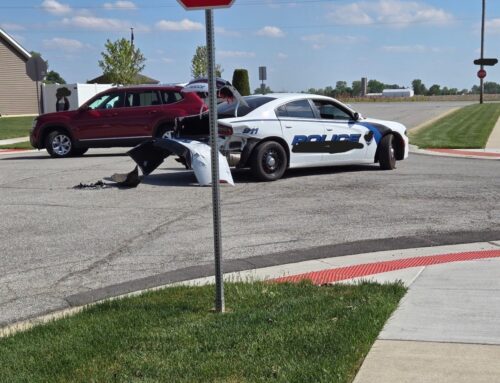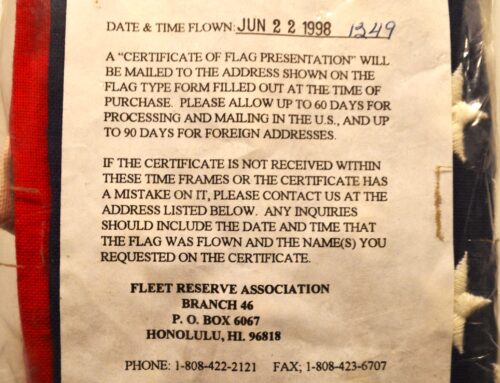Above Picture: Japanese attack of Dutch Harbor, Alaska
The fruits of victory are tumbling into our mouths too quickly. – Emperor Hirohito, April 29, 1942
In 1867 the land mass known as Alaska was purchased by the US from the Russian Empire for just over 7-million dollars.
The sale was brokered by US Secretary of State, William Seward. At the time he was belittled by the press who referred to the endeavor as ‘Seward’s Folly.’ At roughly .02 cents an acre, the mineral and oil wealth it has produced for the nation has more than vindicated both he, and then President Andrew Johnson, billions of times over.
With population growth through gold rushes, trapping, and logging in the interior, and commercial fishing along the southern coast and Aleutian Islands, the US officially incorporated Alaska as a territory in 1912.
WWII
In 1941 the bombing of Pearl Harbor brought the United States, officially, into war with the Japanese Empire.
Japan saw occupation of the Aleutians as prevention of a launch point for potential US attack of the Japanese mainland, as well as a base for their own attacks on the American West coast.
In the early morning hours of June 3, 1942, Japanese aircraft carriers launched torpedo planes towards the Island of Kodiak to attack Dutch Harbor. The planes arrived at 5:45am but were met in the air by American fighters from Fort Glenn Airbase. They hastily dropped their payloads and broke off their mission. Little physical damage was done, however, 17 soldiers lost their lives when a barracks at Ft Myer was struck.
On June 4th, the Japanese hit again! This time destroying fuel oil storage tanks, the Navy radio center, the hospital, a number of aircraft on the ground, and a few commercial vessels, one of which was the S.S. Northwestern. The Northwestern was grounded at Dutch and being used as a power plant and barracks for military operations. Lucky, no one was on board when it was hit, however, between the two days 42 Americans were killed and another 50 injured.
At the Westernmost tip of the Aleutian chain sit the islands of Kiska and Attu. Japanese forces landed and occupied both on June 6 and 7, respectively. This would be the first time a foreign military held ground on US soil since the War of 1812 – It was not received casually by either the American military or public!
Construction of runways and submarine bases could not be allowed to succeed. Doing so would place Seattle and the rest of the West coast in jeopardy. Airstrikes and naval operations commenced immediately.
Of the American military forces involved in the Alaskan campaign, one was a 65-man unit known as The Alaska Scouts – nicknamed Castner’s Cutthroats. Comprised of hunters, trappers, surveyors, and frontiersmen, the Cutthroats were tasked with scouting for intelligence while existing self-sufficiently in the brutal Alaskan terrain. Commanded by Captain Robert H. Thompson and Lt. Earl C. Acuff, both university football stars, the unit was known for its “lose” adherence to military protocols and well as general badassery.
Standard issue weapons were .22 pistols, bolt-action hunting rifles, and available Army issue Garands, but individual members were given latitude to choose their own firearms as they saw fit. Their minimal kit was carried in Trapper Nelson Packs, and uniforms were a combination of Army issue and Alaskan cold weather gear, bearing NO insignia!
On 11 of May, 1943, Operation Landcrab was green-lighted to retake Attu – Kiska would be second.
The Cutthroats went first! They launched rubber boats from submarines offshore, paddled to Attu, and made their way inland. Their mission was reconnaissance for, and to act as a diversion from, the main Army invasion force. Outnumbered 100 to 1, they immediately set up positions and drew enemy fire!
During first contact, the Cutthroats lost 1 man.
The diversion worked, allowing the whole of the 15,000-man American attack force to establish a beachhead. However, the calm was short lived. Once on land, fighting was fierce! The Japanese had constructed emplacements on the high ground, and the weather was brutally cold, with fog, snow and rain all working in tandem to stall American advances as well as resupply. American casualties numbered nearly 4000 – 1600 of which were killed or wounded in battle, the rest resulting from a combination of frostbite, disease, and Japanese booby-traps.
The Battle for Attu lasted until May 23rd. On that day the remaining Japanese launched a Banzai Attack – the last hours consisting of vicious hand-to-hand combat. It is estimated the Japanese lost between 2,300 and 2,800 men. Only 23 were captured alive.
On July 28, 1943, the liberation of Kiska was complete, thus ending the Japanese occupation of US soil, and marking the last day a foreign soldier has held American soil.
On January 3, 1959, Alaska became the 49th state of the Union.
Today, Attu is uninhabited.
The stories of Normandy and Iwo Jima are etched into the memories of WWII History, but there are 1000’s of accounts of valor equally as compelling. The men who took back the cold, barren rock known as Attu, were heroes. On this Memorial Day we remember their fallen.






Leave A Comment
You must be logged in to post a comment.